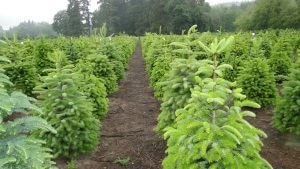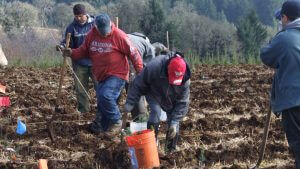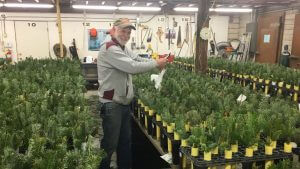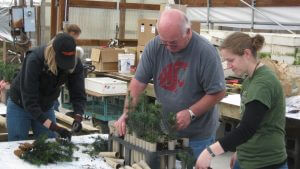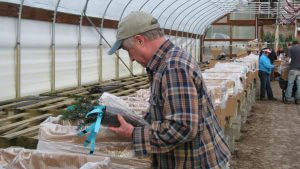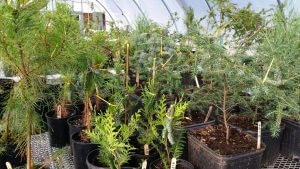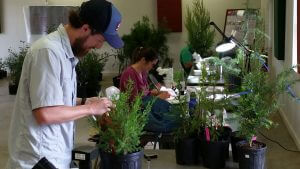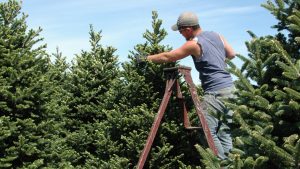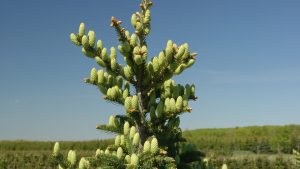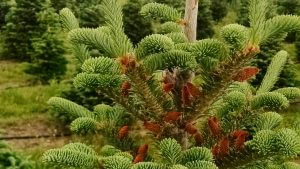Research
Christmas Tree Promotion Board Request for Proposals
The Real Christmas Tree Board (RCTB), also known as the Christmas Tree Promotion Board, is focused on improving the future of the industry by increasing the value and demand for cut Christmas trees through promotion, research and education. The RCTB is a national research and promotion program supported by production assessments from both domestic and imported Christmas trees with oversight by the U.S. Department of Agriculture.
The purpose of the Real Christmas Tree Board Competitive Research Grant Program is to establish and conduct research with respect to the image, desirability, use, marketability, quality, product development or production of Christmas trees; to the end that the marketing and use of Christmas trees may be encouraged, expanded, improved, or made more acceptable and to advance the image, desirability, or quality of Christmas trees.
Research means any type of test, systematic study, investigation, analysis and/or evaluation designed to advance the image, desirability, use, marketability, quality, product development, or production of Christmas trees, including but not limited to research related to cost of production, market development, testing the effectiveness of market development and promotional efforts, new species of Christmas trees and environmental issues relating to the Christmas tree industry.
Please note that all deadlines and funding are contingent upon the annual approval of the RCTB budget and continuation of the RCTB based on future referendum results. Grants may range from $1,000 to $100,000, the amount of funds available for a particular proposal will depend on the number and merit of successful proposals. The funding cycle runs from August 1, through July 31. No-cost extensions are available upon request. Multi-year projects will be considered with the understanding that funding for subsequent years would be contingent on performance and RCTB budget availability. Keep in mind; emergency project funding may be available at any time if an unexpected need arises in your area.
Priorities set for this grant cycle funding include but are not exclusive to:
● Genetic Improvement – All species, all growing regions
● Environmental and Socio-Economic Benefit of Real Trees – Carbon sequestration capabilities, green space, sustainability, economic impact on rural communities
● Insect/Pest Management – especially elongate hemlock scale, wildlife damage, herbicide resistant weeds,
● Improved technology – labor reduction, safety, cost benefit, quality of end-product (baling materials, baler pulling devices, shaking, needle loss)
● Disease Management/Resistance – especially Phytophthora
Please email [email protected] for additional information or questions.
The CTPB is governed by the Commodity Promotion, Research, and Information Act of 1996 (7 U.S.C. 7411-7425) and the Christmas Tree Promotion, Research, and Information Order (7 CFR 1214), which requires all non-proprietary information collected as part of the project will be owned, or jointly owned, by the Christmas Tree Promotion Board (the “CTPB” or the “Board”) subject to the contract provisions below:
Copyright, Patent and Licensing Agreement Provisions
a. The parties agree that information processes or inventions which could be protected by patents or copyrights may be developed as a result of the Project which is the subject of this Agreement.
b. Any inventions, whether or not patentable, copyrights, information, patents, product formulations, processes, or trademarks developed or conceived by Contracted Party within the scope of the work set forth in the contract (collectively, “Intellectual Property”) shall belong jointly to CTPB and to Contracted Party. Contracted Party shall promptly notify CTPB in writing of any such inventions and will cooperate with CTPB in filing of any patent applications. Neither CTPB nor Contracted Party shall sell, license, or otherwise transfer any Intellectual Property developed with the scope of work set forth in the contract without the prior written consent of the other and such consent shall not be unreasonably withheld. Any proceeds from the sale, licensing, or transfer of the Intellectual Property shall belong jointly to CTPB and to Contracted Party pursuant to 7 CFR Part 1214.62 Christmas Tree Promotion, Research and Information Order. All Intellectual Property conceived by Contracted Party outside the scope of the work set forth in the contract shall be and remain the property of the Contracted Party.
Seedling and Transplant Survey Results
CTPB Seedling and Transplant Survey Results 2022
CTPB Seedling and Transplant Survey Results 2021
CTPB Seedling and Transplant Final Report 2020
Research Topic Survey for Christmas Tree Growers – Now Available!
The Real Christmas Tree Board is responsible for utilizing checkoff funds to promote real Christmas trees, and to support scientific, unbiased research improving Christmas tree production. We invite you to complete our short voluntary survey developed to gather input from Christmas tree producers about insect, disease, and other issues that impact your ability to grow high-quality Christmas trees. The information collected by this survey will be used to direct the focus of research grant proposal requests and approvals. Please take the time to complete this survey.
Printed Survey Link: 2024 Research Topic Survey
email to [email protected]
or by mail to:
Cyndi Knudson
Real Christmas Tree Board, Director of Research
2136 Brush Hill Lane
Virginia Beach, VA 23456
Christmas Tree Research Projects Funded by the CTPB – FY 2023-2024
Unlocking novel Christmas tree pest management strategies through genomic resources development
The North Carolina State University (NCSU) Christmas Tree Genetics (CTG) Program in the Department of Forestry and Environmental Resources will develop much needed genomic resources to facilitate development of novel pest management tools for Phytophthora root rot (PRR) and Elongate Hemlock Scale (EHS; Fiorina externa) – two major biotic threats impacting the US Christmas tree industry. Current efforts to manage the threat of these biotic stressors are labor intensive and not viable for large-scale production. To develop novel pest management strategies genomic resources will be generated for both the PRR causal agent (Phytophthora spp.) and EHS to identify putative pest genes and traits involved in pathogenesis/infestation. These efforts will facilitate novel breakthroughs for the management of PRR and EHS on US Christmas tree farms. The overall project goal is to develop a comprehensive set of transcripts/genes for the most significant Christmas tree pests using Fraser fir as the primary study system. Tools developed using Fraser fir can be easily adapted to other Christmas tree species impacted by these pests.
Comparison of long-lasting deer repellents
Damage from winter deer browse and fall buck rubbing has increased on Christmas tree farms. Kwizda Agro GmbH has recently obtained federal registration for a deer repellent, called Trico, using a sprayable emulsion of the body fat of sheep. Tests of that product in New York State by Cornell University personnel have demonstrated that a fall application can protect against browse for the entire winter. An alternative method for growers to make their own version of this repellent, using readily available lanolin has been developed by Connecticut Agricultural Experiment Station. This formulation can easily and legally be manufactured for on farm use by growers. The advantages of this formulation are that it is inexpensive and, based upon the personal protective equipment required for handling, is less toxic. This project will conduct controlled side-by-side comparisons of the lanolin based No-Does vs. the sheep fat- based Trico.
Improving Leyland cypress (Cupressus Å~ leylandii) propagation and production strategies within the Gulf Coast REQUESTED
Mississippi State University will evaluate the viability of several cultivars of Leyland cypress grown within the Gulf Coast region. The interest in working with this material stems from the need for more sustainable systems that require more efficient practices both within the greenhouse during early propagation and within early in-field seedling establishment. The adoption of cultivars that require less fertilizer, less irrigation, and are more pest and disease resistant will ultimately increase producer success and increase the value of products sold. To achieve this goal, Mississippi State University will cooperate with participating members of the Southern Christmas Tree Association (SCTA) by providing plant materials for in-field trials on their farms to evaluate the productivity and success of the Leyland cypress across a variety of growing conditions within the Gulf Coast. This project will establish and evaluate the growth and performance of cuttings through a greenhouse study, facilitating an investigation into sustainable propagation methods that will improve Christmas tree production.
Managing cone formation in Abies Christmas tree species
In this proposed project, Michigan State University research personnel are working with grower cooperators to continue and expand our on-going research to reduce coning impacts on Fraser fir and improve our understanding of factors controlling coning in Fraser fir and other true firs (Abies spp). Requested funds will support on-going research at Michigan State University focused on four objectives:
– Operationalizing post-emergent cone control
– Reducing cone formation through application of plant growth regulators (PGRs)
– Selection of Fraser fir for delayed coning (i.e., trees that will not cone until after typical harvest age)
– Understanding control of coning of true fir Christmas tree species
Improving Christmas tree plantation establishment: Impacts of seedling quality and pre-plant treatments
Mortality of seedlings and transplants is a major concern when establishing conifers for Christmas trees. Seedlings or transplants that die after planting are a direct loss to growers and result in additional costs to replant. Poor seedling or transplant establishment also results in reduced tree growth and reduced plantation uniformity, further adding to grower costs. In this project, Michigan State University will establish field plots with cooperating nurseries to investigate two approaches to improving plantation establishment: managing seedling quality and cultural treatments at planting. A cooperating nursery will produce seedlings with a range of quality attributes (foliar N concentration, root: shoot ratio, sturdiness index caliper/height) and will track survival and growth of the seedlings after out-planting. Also work with cooperating Christmas tree growers will investigate the effects of below-ground treatments (e.g., polymer root dips, bio-stimulants, mycorrhizal inoculation, biochar) and above-ground treatment (e.g., mulch, shade blocks) on growth and survival of Fraser fir seedlings.
Christmas tree genetic improvement through identification of stress defense mechanisms
The University of California-Davis will collaborate with the North Carolina State University Christmas Tree Genetics Program to develop genomic resources for accelerating precision breeding of resistance and consumer-preferred quality traits in fir (Abies spp.) Christmas trees for the U.S. industry. Current genetic improvement methods are insufficient to address rising production losses caused by climate change and increasing pest and disease damage. Advanced breeding strategies are urgently needed to generate trees that can withstand future climate pressures, while meeting consumer preferences. Realizing this goal requires comprehensive genomic resources and knowledge of genes that control desired traits. Leveraging genomic data for Fraser fir generated with prior RCTB support, this project will identify the key genes governing the formation of terpene natural products that play critical roles in conifer pest and pathogen defenses, deter browsing deer, and define tree aroma characteristics. Applying these resources through genomics-assisted breeding can reduce tree improvement cycles from 25-30 to less than 10 years. Developing gene targets for desired traits in Fraser fir will be achieved through (1) mining of available genomics resources for terpene-biosynthetic genes, (2) genomic and biochemical identification of terpene biosynthetic enzymes with predicted functions in defenses against Phytophthora pathogens, and (3) assessing the antimicrobial activity of terpene metabolites abundant in Fraser fir. Collectively, these objectives will generate a detailed knowledge of tree stress-resistance mechanisms and provide gene targets for precision breeding to mitigate the impacts of climate change on Christmas tree production and improve productivity and profitability for U.S. growers.
Optimization of inoculation protocols to identify Abies species with resistance to Phytophthora root rot.
Management of Phytophthora root rot (PRR) in plantations of highly susceptible species of Christmas trees, such as noble and Fraser fir, is a major challenge for growers throughout the U.S. Despite the availability of select chemical alternatives and cultural control methods, practical options for reducing PRR losses in Christmas tree farms are scarce, and their utilization may be limited by expense or feasibility of execution. This often results in Christmas tree farmers having to abandon Phytophthora-infested land for cultivation of these highly desirable species. The screening and identification of other firs with resistance to PRR, such as Nordmann and Turkish fir which are resistant to the common Phytophthora species that cause PRR in the PNW, provide an alternative species for growers to plant, particularly in areas that are conducive to PRR. Screening requires the use of robust procedures to understand specific host: pathogen: environment interactions and current screening efforts rely on very time-consuming inoculum production and inoculation protocols. To optimize and streamline the screening process, Washington State University will assess the possibility of inoculating seedlings using a Peristaltic Dispensing Pump to inject specific quantities of homogenized mycelia into the media seedlings are growing in. This would significantly reduce the time required to produce inoculum and inoculate seedlings. This will allow for larger numbers of seed sources to be screened to the increasing diversity of Phytophthoras found on Christmas trees using a standardized method and identify PRR-resistant material for planting in sites that have a high risk for this disease.
To see outcomes of completed research projects funded by the RCTB visit our research library at www.realchristmastreeboard.org/research-library
Christmas Tree Research: A Growing Investment
The science behind growing and caring for Christmas trees is constantly evolving. The Real Christmas Tree Board is dedicated to funding scientifically sound, unbiased research that will have far reaching impacts on the industry. Over a million dollars has been invested in a slate of research projects designed to produce high quality Christmas trees, manage ever increasing production costs, and minimize environmental impact. Listed below are projects that are complete, and ongoing, being funded by Real Christmas Tree Board Checkoff funds from 2016 to 2023.
- The Cooperative Fir Germplasm Evaluation (CoFirGE) project is designed to identify regionally adapted sources of Turkish and Trojan firs that produce excellent Christmas trees, and to obtain a better understanding of how site and environmental conditions are affecting the growth and postharvest quality of Turkish and Trojan firs.
Connecticut Agricultural Experiment Station, Oregon State University, Washington State University, Pennsylvania State University, Michigan State University, North Carolina State University $89,173
- Understanding the Impact of Elongate Hemlock Scale on Select Tree Species Native to Florida
North Carolina State University $29,750
University of Florida $5,470
- Survey of Slug Species and Development of IPM Strategies for Management of Slugs on Christmas Trees Oregon State University $65,000
Washington State University $15,000
- Managing Cone Formation on Fraser Fir
Michigan State University $151,015
- Fraser Fir Cone Control Research
North Carolina State University $15,903
- Developing Strategies for Leader Control in Nordmann and Turkish Fir
Oregon State University, Michigan State University $12,200
- Spray Drones to Apply Agricultural Materials to Christmas Trees
North Carolina State University $39,600
- Post-Entry Elimination of Megastigmus Seed Larvae in Imported Conifer Seed
Washington State University, Oregon State University $27,575
- Enhanced Establishment and Growth of Bareroot Transplants Using Controlled-Release Fertilizers
Connecticut Agricultural Experiment Station $1,000
- Management Options for Herbicide Resistant Weeds in Christmas Tree Production
North Carolina State University $41,629
- Effectiveness of Preharvest Application of 1-MCP in Reducing Needle Loss on Cut Christmas Trees
Washington State University $32,519
- Evaluation of Nordmann Fir (Abies nordmanniana) Seed Sources for S. Christmas Tree Production
Oregon State University, Washington State University, Pennsylvania State University $76,839
- Twig Weevil- A small poorly understood pest inflicting havoc in the PNW export markets
Washington State University, Oregon State University $95,331
- Susceptibility of Trojan fir to Phytophthora Root Rot
Washington State University $52,921
- Exploring Sustainable Management for Armored Scales in Christmas Tree Plantations
Connecticut Agricultural Experiment Station $36,528
- Investigating Soil Acidification Mechanisms for Inhibiting Phytophthora
Connecticut Agricultural Experiment Station $22,000
- Regional Variation in Needle Loss from Trees in CoFirGE Planting Sites
Washington State University, Oregon State University, Pennsylvania State University, North Carolina State University, Connecticut Agricultural Experiment Station, Michigan State University $30,596
- Surveying for Oregonian Slugs in Hawaii with the Goal of Removing their Quarantine Status
Oregon State University $9,976
- Spotted Lanternfly: A New Exotic Pest Threatening the Mid-Atlantic Christmas Tree Industry
Pennsylvania State University $4,598
- Breeding to produce the next generation of Virginia Pine for Texas/Oklahoma Markets
Texas A & M Forest Service $14,122
- Incorporation of Soil Amendments for Managing Phytophthora Root Rot in Fraser Fir in North Carolina
North Carolina State University $14,264
- Efficacy of ethyl formate fumigation in eradicating elongate hemlock scale on Christmas trees
Washington State University $5,946
- Quantifying genetic variation in needle retention and timing of bud flush in Balsam Fir Christmas Trees for improved performance under climate change in the northeast
University of New Brunswick $24,266
- Improving the viability and vigor of Nordmann and Turkish fir seeds in long-term storage
Washington State University $33,339
- Spotted Lanternfly Training for Christmas Tree Growers
Virginia Tech $5993
- Isolation and development of effective fungal biocontrol for elongate hemlock scale
West Virginia University $79,583
- Effect of Growing Media Properties and Container Geometry on Fraser Fir Germination and Transplant Success
North Carolina State University $41,331
- Viability and Vigor of Heat-Treated Nordmann and Turkish Fir Seed
Washington State University $30,098
- Survey the Fungus Conoideocrella luteorostrata and Monitor Effectiveness as Biocontrol of Elongate Hemlock Scale
West Virginia University $38,192
- Life Cycle Analysis to Determine Net Carbon Sequestration in Commercial Christmas Tree Production
University of New Brunswick and Michigan State University $26,189
- Improving Management of Elongate Hemlock Scale in Fraser Fir Christmas Trees
North Carolina State University $37,244
- Native Selections for Christmas Tree Production in the Southern Coastal Plain of the US
Mississippi State University $26,116
- Mapping Christmas Tree Nutrition Requirements Using Unmanned Aerial Vehicles and Multispectral Sensors
Dalhousie University $9500
- Integrating Biological Control of Armored Scale Pests of Christmas Trees
Connecticut Agricultural Experiment Station $14,622
- Soil Chemistry and Biological Manipulation to Prevent Losses from Phytophthora Root Rot
Connecticut Agricultural Experiment Station $20,649
- Efficacy of BlueFume (HCN) Fumigation in Eradicating Elongate Hemlock Scale on Christmas Trees and Profume Fumigation for Controlling Megastigmus Larvae in Conifer Seed
Washington State University and North Carolina State University $23,853
- Improving viability and vigor of Nordmann and Turkish fir seeds in Long-term Storage
Washington State University $17,930
- Improving First Year Noble Fir Seedling Survival and Growth
Oregon State University $12,917
- The Christmas Tree Genome Project to Rapidly Advance Genetic Improvement
North Carolina State University $50,000
- Evaluation of insecticide alternatives to chlorpyrifos for needle midge management in PNW Douglas fir
Oregon State University $11,325
- Use of Pyroligneous Acid to Improve Postharvest Needle Retention in Balsam Fir Christmas Trees
Dalhousie University $18,098
- Christmas Tree Shopping Environments, Mental Fatigue Recovery and Shopping Preferences: A Nationwide Marketing Study
West Virginia University $12,276
- Screening New Herbicides to Manage Herbicide Resistant Weeds in Christmas Tree
Oregon State University $50,000
- Tree mortality; a potential climate change emerging issue in Christmas tree plantations
Washington State University $27,000
- Unlocking novel Christmas tree pest management strategies through genomic resources development
North Carolina State University $50,000
- Comparison of long-lasting deer repellents
Connecticut Agricultural Experiment Station $16,000
- Improving Leyland cypress (Cupressus Å~ leylandii) propagation and production strategies within the Gulf Coast
Mississippi State University $27,939
- Improving Christmas tree plantation establishment: Impacts of seedling quality and pre-plant treatments
Michigan State University $20,845
- Christmas tree genetic improvement through identification of stress defense mechanisms
University of California Davis $49,799
- Optimization of inoculation protocols to identify Abies species with resistance to Phytophthora root rot.
Washington State University $24,373
In addition to the projects listed above, the RCTB has funded just over $227,127 of consumer research.
- The WA test plot in June 2018
- Planting the Oregon CoFirGe site
- Detached branch needle retention evaluations were done on all of the trees in the Nisqually CoFirGE plot
- Trial seedlings are sorted and tagged
- Trial seedlings are packed for shipping to test plots
- Plants in the greenhouse when they were first infested with EHS. The infested shoots of Fraser fir are attached to each plant
- Dr. Adam Dale and Paige Patterson, Watauga County extension agent, examine the plants for scale and study them under the microscope to determine if they are alive
- Cone removal presents significant labor, time, and potential worker safety issues
- Representation of the significant coverage of cones on untreated trees, as compared to treated trees
- Representation of the significant coverage of cones on untreated trees, as compared to treated trees
